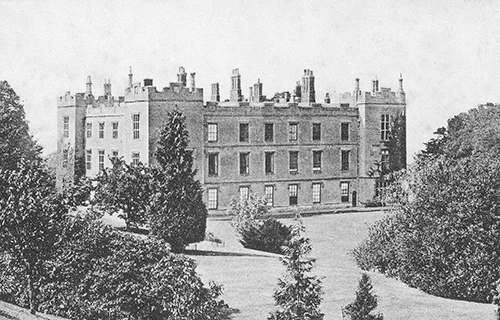Erlestoke Park
| Location | Erlestoke |  Gallery |
||
| County | Wiltshire | |||
| Year demolished | 1929-1930 | |||
| Reason | Surplus to requirements | |||
The Basset family (after whom the village was named) had first built a timber-framed house in the 13th-century. By 1553, the new owner of the manor, Sir John Mervyn (d. 1566) rebuilt the house using a reported 260 oaks, which gives some indication of the size of the house. It was still standing in 1659 and was recorded as being on a U-shaped plan, open to the south east. In 1663, the house and estate were sold to Sir John Weld, of the ancient Dorset family. He made significant changes, spending the colossal sum of £10,000 between 1663-1672 to build the sides up to 130ft and 110ft to create a large rectangle and to then cover over the courtyard. Originally, the house was in a soft, white stone but this renewed in brick in 1814, with the rest of the house following in the late 19th-century, during which it also gained the battlements.
Sir John also added the distinctive corner turrets; a stylistic device which echoed the form of a castle which bears some similarity to the Weld family's main country seat, Lulworth Castle in Dorset,. This was built as a hunting lodge in 1610 by Thomas Howard, 3rd Lord Bindon, and bought by Humphrey Weld (John's elder brother) in 1641, but sadly gutted in a devastating fire in 1929. As Humphrey Weld died (in 1684) without a male heir, Lulworth Castle passed to John's son William who seems to have chosen it as his family seat and sold Compton Bassett in 1700.
The house passed through various owners until it was inherited by George Walker Heneage (d. 1875) who, by 1828 had established an estate covering 1,813 acres in the area. It was Walker Heneage's grandson, Godfrey, who eventually inherited the estate in 1901 but then sold it in 1918 to the Co-Operative Wholesale Society who sold it again in 1929. It was bought by one E.G. Harding who then parcelled up the estate and sold it off piecemeal.
That period was a dark time for the country house in the UK with many being demolished. The house was bought by Captain Sir Guy Benson who sadly decided that he would rather live in the stables and so this wonderful house was levelled in the early 1930s and the stables converted in 1935 into the new Compton Bassett House.